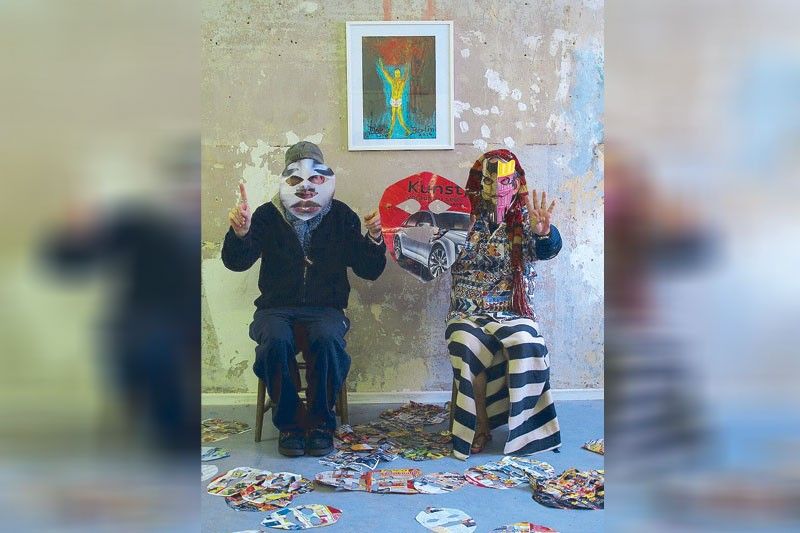Uncovering masks at the 2020 London Biennale

There’s a collective lamentation for in-the-flesh communication as we once knew it. Masks have become essential, at the price of obscuring entire regions of faces along with their accompanying cues and nuances. Simple transactional conversations often end up repeated at least twice as the parties involved decipher voices through fabric. Even in brief encounters with friends, smiles are denied. The primacy of connection then turns to physical acts like a slouch, crossed arms, or a calculated step back. When ways of showing are concealed, other gestures can be telling.
Timely is the theme of the 2020 London Biennale: “Masks, Mirages, and the Morphic Mirror,” inspired by a Walt Whitman poem. When founder and director David Medalla and international coordinator Adam Nankervis decided on it in mid-2019, its foresight had yet to be revealed. As per the London Biennale’s website, it was “an untimely and absurd prophetic concurrence with the global pandemic.” Then again, the London Biennale has a track record of prescience.
The 10th iteration of the London Biennale is currently online, broadcasting images accompanied by artist manifests on londonbiennale.net and a corresponding Facebook page. There are also plans to exhibit the works in New York, Berlin, London and Lucban. The internet itself turns out to be an apt platform for the mobile nature of the London Biennale, whose Pollinations have taken place across different continents.
While Medalla has employed masks in his art as far back as the 1980s, the mask itself, which figures into a broad range of metaphors throughout art history, is now a distinctly jarring mark of the times that’s present anywhere there’s a crowd. I’ve grown attuned to its myriad varieties: N95 respirators and the electrostatic filtration that belies them, cheeky printed lips of celebrities on Divisoria cloth masks, and repurposed clothes. The mask indicates class, occupation, culture and belief. It speaks volumes about the one who wears it.
The opening image of the London Biennale’s website is Daniel Kupferberg’s photo of Medalla and Nankervis, holding up masks cut out of glossies, with several more scattered on the floor. They hold up a third mask cut out of an automobile ad declaring “Kunst, vorasdawus zu sein,” which roughly translates to “the art of progress.” Where, then, do we go from here?
The participating artists from around the globe present different facets of the mask, tackling aspects of identity (“For Anonymity,” Nina DeFelice), intimacy (“missing kissing,” Hae-yeon Shin), and resistance (Reynolds). In keeping up with the demands of social distancing, a neighboring city is rendered as distant as South America. The social media album becomes a series of windows, with a view of specific instances and events where the artist is situated.
Digital images also subject themselves to being transformed on a wide variety of scales and resolutions, from thumbnails to being enlarged and pixelated to the point of abstraction. This malleability lends itself to play and discovery. Jason Dy, SJ’s performance “Be a Tree Anotong” (2020) was shown as a photo of a large fern amidst a forest. Zooming in on the screen revealed the person standing behind it. The plant itself was the mask, but I swore I caught hints of eyes and a mouth somewhere.
The curious aftereffect of browsing through the images is an impulse to see faces elsewhere, even in the inanimate, as though androids do dream of facial recognition. Viewing art in your own home blurs the lines between the domestic and the art space, yielding results that hold surprises of their own. Objects familiar to the point of becoming white noise are suddenly recontextualized through the psychological machinations. As with a Rorschach test or a mirror, you finally see what was there all along.
This is where the London Biennale transmutes a mask into a morphic mirror by imbuing the object with a very human impulse which the aforementioned Whitman poem poignantly narrates. “Out from Behind This Mask (To Confront a Portrait)” reads, “Pausing, inclining, baring my head, you specially I greet / To draw and clinch your soul for once inseparably with mine / Then travel travel on.”
We dance around the idea of mortality — not to avoid it, nor deny it, but to face our lives, with our inevitable fate considered. Putting on a mask on an everyday basis is an acknowledgment of precarity, knowing that this could be the deciding factor if you live to see the next day. At its most fundamental, wearing a mask is a demonstration of the desire to survive. The London Biennale’s “Masks, Mirages, and the Morphic Mirror” attests to the will to be alive, in all its exuberance.



















